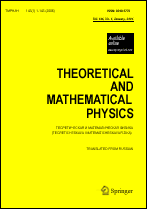|
This article is cited in 4 scientific papers (total in 4 papers)
The $k$-essence in the relativistic theory of gravitation and general relativity
Yu. V. Chugreev
Lomonosov Moscow State University, Moscow, Russia
Abstract:
We consider a model of a scalar field with a nontrivial kinetic part ($k$-essence) on the background of a flat homogeneous isotropic universe in the framework of the relativistic theory of gravitation and general relativity. Such a scalar field simulates the substance of an ideal fluid and serves as a model of dark energy because it leads to cosmological acceleration at later times. For finding a suitable cosmological scenario, it is more convenient to determine the dependence of the energy density of such a field on the scale factor and only then find the corresponding Lagrangian. Based on the solution of such an inverse problem, we show that in the relativistic theory of gravitation, either any scalar field of this type leads to instabilities, or the compression stage ends at an unacceptably early stage. We note that a consistent model of dark energy in the relativistic theory of gravitation can be a scalar field with a negative potential (ekpyrosis) of Steinhardt–Turok. In general relativity, the $k$-essence model is viable and can represent both dark energy and dark matter. We consider several specific $k$-essence models.
Keywords:
RTG, $k$-essence, inverse, ekpyrosis, Chaplygin gas.
Received: 26.01.2017
Revised: 07.04.2017
Citation:
Yu. V. Chugreev, “The $k$-essence in the relativistic theory of gravitation and general relativity”, TMF, 194:3 (2018), 510–521; Theoret. and Math. Phys., 194:3 (2018), 439–449
Linking options:
https://www.mathnet.ru/eng/tmf9347https://doi.org/10.4213/tmf9347 https://www.mathnet.ru/eng/tmf/v194/i3/p510
|


|




 Contact us:
Contact us: Terms of Use
Terms of Use
 Registration to the website
Registration to the website Logotypes
Logotypes








 Citation in format
Citation in format 
